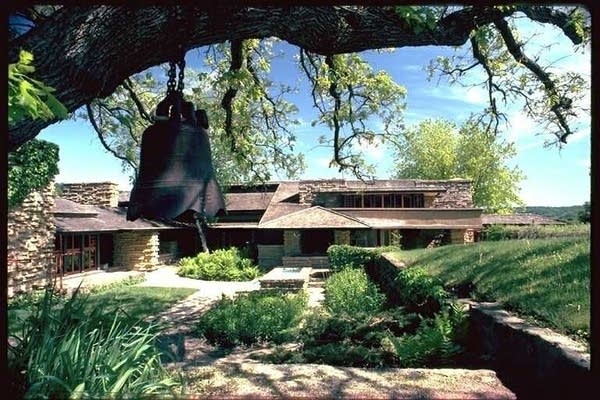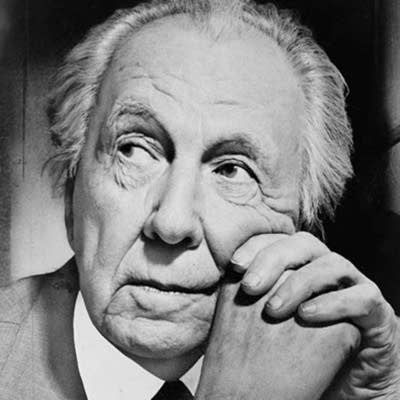Frank Lloyd Wright: One of the greatest, and most controversial

Does your home have a living room? A carport? Does your house have an open floor plan? If so, the way you live is being directly influenced by Frank Lloyd Wright's innovations in residential architecture.
We are so familiar with our modern homes that it's hard to imagine how radical Wright's "organic architecture" was to people in his time.

Although a few of Wright's early contemporaries were beginning to break free from the strictures of Victorian design, when Wright was setting up his practice in suburban Chicago more than 100 years ago, American architecture was dominated by European styles that dated back hundreds of years.
Wright's inspiration for his new indigenous architecture had its roots in the flat, expansive prairie landscape of the Midwest, where he grew up.
Create a More Connected Minnesota
MPR News is your trusted resource for the news you need. With your support, MPR News brings accessible, courageous journalism and authentic conversation to everyone - free of paywalls and barriers. Your gift makes a difference.
"The prairie has a beauty of its own and we should recognize and accentuate this natural beauty, its quiet level," he wrote.
Into 1909, Wright developed and refined what came to be known as the Prairie School of architecture, which is considered part of the Arts and Crafts movement.
The typical Prairie style home is distinguished by horizontal lines on the exterior, emphasized by a low-pitched hipped roof, long bands of windows, wide overhanging eaves and brick courses or wood bands.

Inside, the floor plan is open and radiates outward from a central fireplace. Construction materials and finishes are natural, and ornamentation is often restricted to art glass windows that function as "light screens," blurring the distinction between interior and exterior spaces.
A master of special effects, Wright used variations in color, ceiling heights and hallway widths to alternately compress and expand the sense of space as a person moved through the buildings he created.
The S.C. Johnson corporate headquarters in Racine, Wisconsin, so artfully modulates light with huge circular screens towards the ceiling that the effect is that of being underwater in a lily pond.
Wright's designs went beyond the building to the finest details of the interior space, to include furniture, art glass, and other aspects of interior design.

The ultimate micromanager, he was known to design gowns for the mistress of the house, and he cleverly shaped rooms and furnishings to promote idealized activities for the occupants. Apparently he had little concern for cooking, judging by the small space allotted to kitchens.
At Taliesen, his southern Wisconsin home, school, and laboratory, he even extended the range of his design to the landscape, realigning roads and developing water features.
Innovative designs and use of experimental materials sometimes resulted in imperfect construction. Many of the buildings were notoriously leaky, and didn't stand up well to the harsh winters of the upper Midwest. In fact, Taliesin itself had fallen into a sad state of disrepair a few decades ago, and Wright's proteges raised millions of dollars in private fundraising to restore the building.
In 1934, one of Wright's apprentices, Edgar Kaufmann Jr., convinced his father to let Wright design a summer home for him near Bear Run, Pennsylvania. Out of that association came Wright's masterpiece, Fallingwater, the house built on the waterfall.

At the other end of the financial spectrum, Wright was developing his vision for modestly priced homes. His first "Usonian" house was the Jacobs house near Madison, Wisconsin.
Wright believed that everyone should have an architect design a house specifically for them, no matter what the price of the house was, instead of living in a "cookie-cutter" house.
While most of his designs were single-family homes, Wright also designed a wide variety of other buildings, including houses of worship, factories, skyscrapers, resorts, museums, government offices, gas stations and bridges.
Later in his career he expanded his vision to incorporate whole communities; his Broadacre City expressed a utopian vision of graceful towers and domiciles set within peaceful park-like landscapes.

One of the most famous of his buildings is the Guggenheim Museum in New York City, with its round shell-like design.
In 1943, Wright accepted a commission from Solomon R. Guggenheim to design the museum. After enduring delays caused by World War II, Guggenheim's death, and numerous discussions with the building commission, construction finally began in 1957. Construction lasted almost two years, and the museum opened in October 1959.
Wright never got to see the completion of the Guggenheim Museum. On April 4, 1959, Wright had surgery for an intestinal blockage. Seeming to be recovering as expected, he suddenly died five days later on April 9, at the age of 91.
Wright's designs continue to be built fresh today. In 2002, Minneapolis took one of his bridge designs as inspiration for a crossing of Third Ave. over I-94.

And in 1997, Madison, Wisconsin, opened what may be the most recent Wright-designed building. The Monona Terrace Community and Convention Center opened its doors after nearly 60 years of debate. It was first designed by Wright in 1938 as a cultural, governmental and recreational building, and is strikingly similar to the Guggenheim's design.
Ongoing political debates at the county and local levels required Wright to rework the design several times between 1938 and 1958, before signing off on the final plans seven weeks before his death in 1959.
In 1992, Madison voters approved referenda to construct Monona Terrace -- on the same site Wright had originally proposed -- as a community and convention center.
While Wright's design was used for the building's exterior, the interior was redesigned by Wright apprentice and Taliesin architect Tony Puttnam to house state-of-the-art exhibition, meeting and public space.

